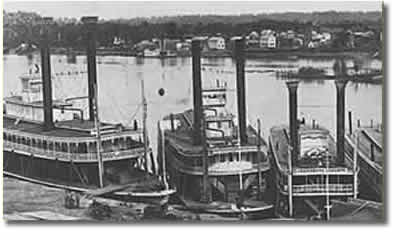Steamboating the Minnesota River
Thousands of immigrants were carried to their "promised land" up the Minnesota River by small steamboats
.
|
 |
|
|
Steamboating Heyday
The Early Days
Big Business |
||
 |
Bell Foretold Arrival Every boat on the river had a bell, and every bell had its own tone. People living near the river knew which boat was coming by the sound. Some bells were recycled when their boats were scrapped. The bell of the Montello sat atop an old school building in Henderson for many years and is now in the Sibley County Museum. |
|
|
Navigability Always a Problem The Minnesota was full of sandbars: one large one a short distance above Mendota gave trouble even to little boats such as the Antelope. But the main obstruction in the Minnesota was what was known as the Little Rapids a ledge of soft sandstone lying across the stream 7 miles above Shakopee. In the 1850s a series of locks was proposed to overcome this impediment, but nothing was done. |
||
 |
Railroads The idea of maintaining the Minnesota as a navigable river lingered for decades after the steamboat era, but the coming of railroads and their river-spanning bridges in the late 1860s doomed the idea. |
|
|
This page was last updated 4/15/03 |
||
